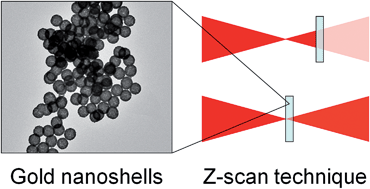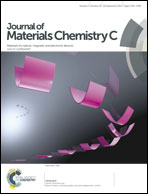Shell-thickness-dependent nonlinear optical properties of colloidal gold nanoshells†
Abstract
Third-order nonlinear optical properties of gold nanoshells of different thickness were investigated over a broad wavelength range (530–1200 nm) by the Z-scan technique using femtosecond laser pulses. Nonlinear absorption of the nanoshells is dominated by strong absorption saturation phenomena. The reciprocals of the relevant saturation intensities are the highest at the maxima of one-photon absorption (1 PA) bands for all the studied nanoshells but the scaling with the one-photon extinction coefficients within the relevant absorption bands is rather approximate. The reciprocals of the saturation intensities scaled by the values of the extinction coefficients are also found to decrease with the increase of the shell thickness. This can be attributed mostly to the increase of the contribution of the scattering of NIR light to the total extinction of the solutions. The two-photon absorption (2 PA) behavior is found to be dominant only within the shortest wavelength range studied for the gold nanoshells with the thinnest shells which exhibit high 2 PA cross-section values, with σ2 reaching 5.1 × 1010 GM.


 Please wait while we load your content...
Please wait while we load your content...